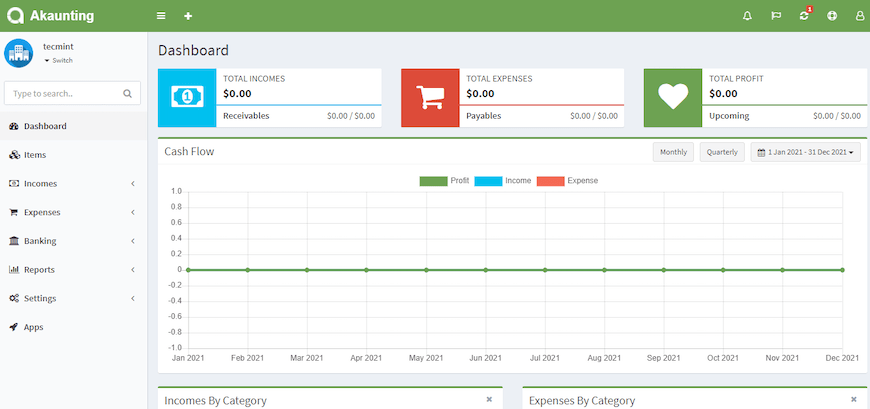
In this tutorial, we will show you how to install Akaunting on Ubuntu 20.04 LTS. For those of you who didn’t know, Akaunting is a free, open-source, and online accounting software designed for small businesses and freelancers. This tool is built with modern technologies such as Laravel, Bootstrap, jQuery, RESTful API, and others.
This article assumes you have at least basic knowledge of Linux, know how to use the shell, and most importantly, you host your site on your own VPS. The installation is quite simple and assumes you are running in the root account, if not you may need to add ‘sudo‘ to the commands to get root privileges. I will show you through the step-by-step installation of Akaunting Self-Hosted Accounting Software on Ubuntu 20.04 (Focal Fossa). You can follow the same instructions for Ubuntu 18.04, 16.04, and any other Debian-based distribution like Linux Mint.
Prerequisites
- A server running one of the following operating systems: Ubuntu 20.04, 18.04, 16.04, and any other Debian-based distribution like Linux Mint.
- It’s recommended that you use a fresh OS install to prevent any potential issues.
- A
non-root sudo useror access to theroot user. We recommend acting as anon-root sudo user, however, as you can harm your system if you’re not careful when acting as the root.
Install Akaunting on Ubuntu 20.04 LTS Focal Fossa
Step 1. First, make sure that all your system packages are up-to-date by running the following apt commands in the terminal.
sudo apt update sudo apt upgrade
Step 2. Install the LAMP stack.
A Ubuntu 20.04 LAMP server is required. If you do not have LAMP installed, you can follow our guide here.
Step 3. Installing Akaunting on Ubuntu 20.04.
Now we run the commands below to download the latest version of Akaunting:
wget -O Akaunting.zip https://akaunting.com/download.php?version=latest
Then, create a new directory and unzip the downloaded file with the following commands:
sudo mkdir -p /var/www/akaunting/ sudo unzip Akaunting.zip -d /var/www/akaunting/
We will need to change some folders permissions:
sudo chown -R www-data:www-data /var/www/akaunting/ sudo chmod -R 755 /var/www/akaunting/
Step 4. Configuring MariaDB for Akaunting.
By default, MariaDB is not hardened. You can secure MariaDB using the mysql_secure_installation script. you should read and below each step carefully which will set a root password, remove anonymous users, disallow remote root login, and remove the test database and access to secure MariaDB:
mysql_secure_installation
Configure it like this:
- Set root password? [Y/n] y - Remove anonymous users? [Y/n] y - Disallow root login remotely? [Y/n] y - Remove test database and access to it? [Y/n] y - Reload privilege tables now? [Y/n] y
Next, we will need to log in to the MariaDB console and create a database for the Akaunting. Run the following command:
mysql -u root -p
This will prompt you for a password, so enter your MariaDB root password and hit Enter. Once you are logged in to your database server you need to create a database for Akaunting installation:
CREATE DATABASE akauntingdb; CREATE USER 'akaunting'@'localhost' IDENTIFIED BY 'YOUR-PASSWORD'; GRANT ALL ON akauntingdb.* TO 'akaunting'@'localhost' IDENTIFIED BY 'PASSWORD' WITH GRANT OPTION; FLUSH PRIVILEGES; exit
Step 5. Configuring Apache for Akaunting.
Now create a new virtual host configuration file with the command:
sudo nano /etc/apache2/sites-available/akaunting.conf
Add the following lines:
<VirtualHost *:80>
ServerName your-domain.com
DocumentRoot /var/www/akaunting/
<Directory /var/www/akaunting/>
DirectoryIndex index.php
Options +FollowSymLinks
AllowOverride All
Require all granted
</Directory>
ErrorLog ${APACHE_LOG_DIR}/akaunting.error.log
CustomLog ${APACHE_LOG_DIR}/akaunting.access.log combined
</VirtualHost>
Now, we can restart the Apache webserver so that the changes take place:
sudo a2ensite akaunting.conf sudo a2enmod rewrite sudo systemctl restart apache2
Step 6. Set up HTTPS.
We should enable a secure HTTPS connection on Nextcloud. We can obtain a free TLS certificate from Let’s Encrypt. Install Let’s Encrypt client (certbot) from Ubuntu 20.04 repository:
sudo apt install certbot python3-certbot-apache
Next, run the following command to obtain a free TLS certificate using the Apache plugin:
sudo certbot --apache --agree-tos --redirect --staple-ocsp --email you@example.com -d example.com
If the test is successful, reload Apache for the change to take effect:
sudo apache2ctl -t sudo systemctl reload apache2
Step 7. Accessing Akaunting Web Interface.
Akaunting will be available on HTTP port 80 by default. Open your favorite browser and navigate to https://your-domain.com/ and complete the required steps to finish the installation. If you are using a firewall, please open port 80 to enable access to the control panel.

Congratulations! You have successfully installed Akaunting. Thanks for using this tutorial for installing the Akaunting Self-Hosted Accounting Software on your Ubuntu 20.04 LTS Focal Fossa system. For additional help or useful information, we recommend you check the official Akaunting website.